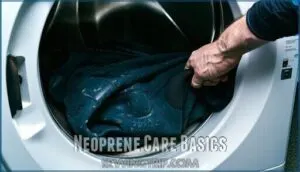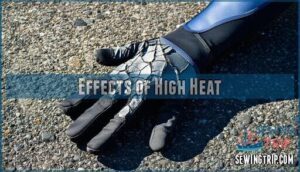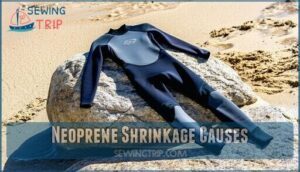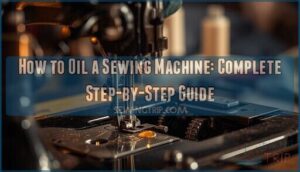This site is supported by our readers. We may earn a commission, at no cost to you, if you purchase through links.

This material, commonly used in wetsuits and other gear, reacts to heat by tightening and losing its flexibility.
While it might seem tempting to toss it in the dryer for convenience, doing so risks distorting its shape, hardening the fabric, or even reducing its lifespan.
If you must use a dryer, stick to the lowest heat setting and place it in a mesh laundry bag to minimize damage.
Air drying is often the safest option to keep neoprene in great shape.
Curious about other care tips? Stay tuned.
Table Of Contents
Key Takeaways
- Neoprene shrinks in the dryer, especially with high heat, which can damage its elasticity and distort its shape.
- Always air dry neoprene in the shade to avoid heat damage and maintain its flexibility and fit.
- Heat exposure, including sunlight, weakens neoprene over time, causing shrinkage and hardening.
- Regular care, like rinsing after use and avoiding dryers, ensures neoprene lasts longer and performs well.
Neoprene Care Basics
Taking care of neoprene properly helps it last longer and keeps it in good shape.
Proper neoprene care ensures durability, flexibility, and long-lasting performance—preserve its quality with gentle handling, air drying, and smart storage.
You’ll need to stick to gentle washing, avoid high heat, and store it correctly to prevent damage.
General Maintenance Tips
To keep neoprene in great shape, focus on regular cleaning with mild soap, thorough rinsing, and air drying away from sunlight.
Inspecting seams prevents small issues from worsening. Keep zippers clean and lubricated for smooth operation.
You may want to think about using a specialized cleaning product for best results.
Avoid harsh chemicals and choose proper storage—like hanging wetsuits flat.
Good neoprene care reduces heat damage and delays shrinkage or dryer effects.
Washing and Drying Methods
Washing neoprene requires cold or warm water to avoid neoprene shrinkage.
Use mild soap or neoprene-specific cleaners.
Hand washing is best, but if using a machine, choose gentle settings under 40°C.
For drying wetsuits, air drying is safer.
Avoid high-heat dryer effects, as they damage elasticity.
Proper neoprene care begins with careful washing temperatures and drying techniques.
Consider using a specialized neoprene wash for best results.
Storage and Handling Precautions
When storing neoprene, avoid folding to prevent creases that lead to neoprene shrinkage.
Use proper hanging methods, keeping wetsuits away from embellished items to reduce neoprene damage.
Inspect frequently for wear, and store in a cool, dry environment to maintain elasticity.
To maintain the quality of the neoprene, consider controlling temperature and humidity.
Proper wetsuit care guarantees longevity, as a poorly stored or drying wetsuit can lose shape or degrade quickly.
Does Neoprene Shrink
Yes, neoprene can shrink, especially when exposed to high heat.
The synthetic rubber material reacts to heat exposure, causing it to lose flexibility and elasticity over time. While shrinking may seem reversible, it’s not always practical.
Here’s what you need to know:
- Shrinkage Reversibility: Stretching methods like using a heat gun or soaking may help, but results vary.
- Heat Gun Use: Controlled application can shrink neoprene slightly if done professionally; improper use risks neoprene damage.
- Professional Alterations: Adjustments are effective but can be costly compared to replacement costs.
- Replacement Costs: Significant shrinking often leads to replacing the product.
Neoprene’s ability to shrink highlights the importance of avoiding dryers and excessive heat exposure for prolonged use. It’s also worth noting that neoprene stretches over time, so consider this when selecting the right size.
Neoprene Dryer Damage
Putting neoprene in the dryer exposes it to high heat, which can cause irreversible damage like shrinking or hardening.
High heat from dryers ruins neoprene’s elasticity, leading to permanent shrinkage, hardening, and reduced performance—choose air drying to protect your gear.
Even low heat settings aren’t safe, as they weaken the fabric’s elasticity and shorten its lifespan.
Effects of High Heat
High heat exposure pushes neoprene past its limits, causing heat degradation. You’ll notice elasticity loss, cracking risks, and structural damage over time.
The dryer’s heat can even weaken adhesive bonds, leading to peeling or splits. For such damage, consider using specialized repair solutions.
While neoprene resists melting, it hardens with prolonged heat exposure, reducing flexibility. Avoid heat damage by skipping the dryer—air drying is your safest bet.
Consequences of Tumble Drying
Tumble drying can wreak havoc on neoprene properties.
Heat damage shrinks the fabric, distorts its shape, and weakens structural integrity.
Elasticity loss is common, making garments less flexible and effective.
Even low dryer settings lead to fabric damage over time.
As heat exposure accelerates, performance reduction and lifespan shortening follow, leaving neoprene stiff, brittle, and in need of premature replacement, resulting in a significant loss of elasticity.
Risks of Shrinking and Hardening
Heat exposure from dryer settings can wreak havoc on neoprene properties, causing irreversible damage.
The material may shrink, harden, or lose its elasticity, leading to performance decline and structural weakening.
Once fabric damage occurs, you’ll notice reduced stretch and comfort.
Plus, using a dryer on neoprene voids warranties, so stick to air drying to preserve it and maintain its elasticity.
Neoprene Shrinkage Causes
Neoprene shrinkage happens when heat, UV exposure, or low-quality materials affect its structure. Understanding these causes helps you avoid damage and keep your gear in great shape.
Heat Exposure Risks
Exposing neoprene to heat can ruin its elasticity and cause irreversible damage.
Avoid shrinking and heat hardening by steering clear of high temperatures. Here’s why:
- Dryer Damage: High heat warps the fabric, reducing flexibility.
- Sunlight Degradation: Prolonged exposure breaks neoprene down.
- Heat Exposure: Even gentle heat weakens materials over time.
Air drying protects from damage!
UV Damage and Aging
UV rays gradually break down neoprene, making it brittle over time.
Sun exposure speeds up this process, causing the material to age quickly and lose flexibility. Prolonged UV degradation leads to gradual shrinkage, reducing the product’s lifespan.
Neoprene can also experience permanent stretch over time, impacting its fit.
To avoid sun damage, store neoprene in shaded, cool areas. Regular care helps prevent brittleness factors and preserves its durability.
Quality and Manufacturing Factors
Neoprene’s shrinking depends on material composition and manufacturing.
High-quality fabrics with controlled cell structure and fabric density handle heat better than low-grade neoprene.
The manufacturing process, including quality control in synthetic rubbers, reduces risks like shrinkage and warping.
Cheaper neoprene often lacks the durability of premium options, compromising long-term performance.
Choose well-made neoprene to minimize damage from heat exposure and ensure long-term quality.
Safe Drying Methods
When drying neoprene, it’s important to prevent damage by avoiding high heat and direct sunlight.
Using safe methods like air drying or low-heat settings guarantees the material stays flexible and lasts longer, which is a complete concept for maintaining neoprene.
Air Drying Recommendations
Shade is best when air drying neoprene fabric.
Avoid sunlight, as direct UV rays can damage and weaken the material, leading to shrinking fabric.
Proper airflow importance can’t be overstated—hang your wetsuit drying on a sturdy hanger to guarantee complete dryness.
Always position it indoors or in a shaded area to protect its elasticity and shape, ensuring proper airflow is maintained.
Low Heat Settings and Precautions
Drying neoprene safely requires careful choices.
Use gentle cycles only, keeping the dryer on a low temperature to avoid shrinking.
Low heat dangers include hardening or loss of flexibility, so stick to short intervals.
Add a damp cloth and a tennis ball method to help maintain shape.
Even with precautions, air drying is typically the safer option.
Mesh Laundry Bag Protection
Protect neoprene fabric in the dryer by using a mesh laundry bag. It reduces friction, prevents fabric shrinking, and avoids heat-related damage.
Here’s how:
- Choose a bag material with strong zipper quality for durability.
- Make certain size matters—neoprene items shouldn’t overcrowd.
- Opt for damage prevention by pairing with low heat or air dry.
- Consider alternative options like hang drying.
Neoprene Shrinkage Prevention
You can keep neoprene from shrinking by avoiding dryers, direct sunlight, and high heat. Regular inspections and proper storage will also help maintain its elasticity and shape over time.
Regular Inspection and Maintenance
After drying neoprene properly, don’t skip regular checks for seam integrity and zipper maintenance.
Rinse off saltwater and handle odor control with gentle cleaners to preserve the neoprene fabric.
Early detection of wear helps with damage prevention. Inspect care instructions to avoid material shrinkage.
Keeping an eye on these simple steps guarantees your gear stays functional longer, which is key to material preservation.
Avoiding Direct Sunlight and Heat
When you expose neoprene to direct sunlight or high heat, UV degradation and heat hardening can kick in, leading to gradual shrinkage.
Always dry it in the shade to guarantee safe temperatures and avoid using a dryer.
These steps protect your gear from shrinking while preventing damage. Proper care here isn’t optional—it’s essential for long-lasting performance.
Proper Storage and Handling
Always hang your neoprene instead of folding it to prevent creases and shrinking.
Keep it away from embellishments that might scratch or damage the fabric. Rinse thoroughly after each use, and inspect regularly for wear.
To guarantee longevity, consider controlling temperature and humidity.
Cleaning frequency matters—don’t skip it! Store in a cool, dry spot to avoid heat damage, which mimics the effects of a dryer.
Neoprene Shrinkage Effects
When neoprene shrinks in the dryer, it loses elasticity and becomes less flexible, making it uncomfortable to wear.
This shrinkage can also distort the shape, reduce the fit, and shorten the lifespan of your gear.
Loss of Elasticity and Flexibility
Heat degradation and UV exposure lead to gradual hardening and brittleness in neoprene fabric, reducing its elasticity.
Over time, stretching and friction cause stiffening effects, making it prone to tears.
Using a dryer accelerates this process, promoting UV brittleness and reduced stretch.
To avoid shrinking and loss of flexibility, air-drying your neoprene is the safest method to prevent shrinking.
Distortion of Shape and Fit
When neoprene shrinks due to heat or improper drying, it can lose its shape, leading to seam stress and awkward fits.
This distortion affects mobility, reducing comfort and causing performance issues. Imagine struggling to zip up or move freely—frustrating, right?
It could even lower resale value. Neoprene’s elasticity depends on proper care, so avoid excessive heat to maintain its fit.
Reduced Lifespan and Performance
Using a dryer can cause heat damage to neoprene, leading to elasticity loss and flexibility issues.
Over time, this structural weakening results in durability degradation and a noticeable performance impact.
As neoprene shrinks, the material stiffens, affecting its fit and comfort.
Avoid excessive heat to preserve its lifespan and guarantee your gear stays reliable for longer adventures.
Neoprene Shrinkage Rates
Neoprene shrinkage happens when heat, aging, or poor care weaken its structure over time.
While some shrinkage is gradual, high heat from dryers can cause rapid changes, leaving your gear stiff and poorly fitting.
Factors Influencing Shrinkage
Several factors influence neoprene shrinking. Prolonged heat exposure, like from a dryer, can reduce elasticity.
UV radiation and aging effects also weaken neoprene fabric, making it more prone to shrinkage. Material quality varies—high-grade neoprene resists shrinking better.
Drying methods matter too; air drying guarantees safety, while improper heat shrinking damages the structure. Always opt for low-heat precautions to prevent shrinking.
Gradual Vs. Rapid Shrinkage
Shrinkage can happen gradually over months or rapidly with heat exposure from a dryer or harsh conditions.
UV degradation, frequent use, or older, lower-quality neoprene fabric speeds up gradual stiffening and loss of elasticity.
Rapid shrinking is usually due to high-temperature drying, which damages both flexibility and fit.
Material quality and usage frequency also play a big role in how shrinking occurs.
Measuring and Monitoring Shrinkage
Keep track of neoprene fabric shrinkage with pre-shrinkage measurements and post-wash comparisons.
Monitor dimensional changes after washing or drying to calculate shrinkage percentages accurately.
Regular monitoring guarantees early detection of issues caused by heat or improper handling.
Since dryers often accelerate fabric shrinkage, measuring and tracking changes can help you maintain the fit and performance of your items over time.
Alternatives to Dryer Use
You don’t need a dryer to safely dry your neoprene items.
Simple methods like air drying in shade or using gentle heat near a radiator can protect the material and maintain its shape.
Hang Drying and Shade Protection
Hang drying in the shade is your best bet to protect neoprene.
Direct sunlight weakens it over time, so pick a spot with good airflow for faster drying time.
Shade also helps with shape retention and prevents mildew buildup.
Avoiding UV rays guarantees long-lasting flexibility, keeping your gear in top condition without compromising performance.
Air drying is simple and effective!
Gentle Heat and Radiator Precautions
Using gentle heat like a radiator can prevent damage but requires care.
Always maintain safe distances to avoid overheating. Gradual shrinkage and heat degradation can still occur with low-temperature risks.
Follow these tips:
- Keep neoprene 2-3 feet from the radiator.
- Avoid direct contact.
- Limit exposure to 15-30 minutes.
- Turn it inside out for even drying.
- Monitor temperature carefully.
Neoprene Longevity Tips
If you want your neoprene gear to last, focus on regular care and smart storage.
Simple habits like rinsing after use and avoiding heat can go a long way in preserving its flexibility and shape.
Proper Care and Maintenance
Proper neoprene care keeps it lasting longer.
Use gentle soaps, rinse thoroughly, and avoid heat to prevent damage.
Air drying is best—skip the dryer.
Regular cleaning helps maintain flexibility and prevents shrink.
Inspect frequently for wear, storing in a cool, dry spot to protect the fabric.
Handle with care to avoid tears or compromised elasticity.
| Tip | Why It Matters | Action to Take |
|---|---|---|
| Regular Cleaning | Prevents buildup | Rinse after each use |
| Proper Storage | Maintains shape | Hang in a cool place |
| Avoiding Damage | Extends lifespan | Handle gently |
Regular Cleaning and Inspection
Inspect your neoprene often to catch shrinking or damage early.
Rinse it thoroughly after each use—especially saltwater exposure—to maintain flexibility. Check seam integrity and zippers for wear, as weak spots worsen over time.
Regularly assess for heat damage to avoid surprises. Proper rinsing frequency and careful damage assessment guarantee your gear stays in top shape and dryer-free for years.
Storage and Handling Best Practices
Neoprene needs careful storage to stay in top shape.
It is crucial to keep it in a cool, dry spot to avoid shrinking and damage.
Use these tips to maintain your neoprene:
- Avoid folding to prevent creases and loss of form.
- Use hanging methods to maintain shape, away from direct heat.
- Keep neoprene material away from embellishment contact to avoid snags.
Routine inspections are essential to catch wear early, ensuring your neoprene remains in good condition.
Frequently Asked Questions (FAQs)
Does neoprene shrink?
Heat, sunlight, and time are neoprene’s kryptonite.
Yes, neoprene shrinks, especially when exposed to high heat like in a dryer.
To avoid shrinking disasters, stick to air drying in a cool, shaded spot.
Will a dryer break down neoprene?
A dryer can break down neoprene by exposing it to high heat, which weakens its elasticity, hardens the material, and damages its structure.
Stick to air drying to keep your neoprene gear in great shape!
Does nylon shrink in the dryer?
Nylon doesn’t usually shrink in the dryer, but high heat can make it lose shape or weaken fibers over time.
Use low or delicate settings, and air drying is always a safer bet.
Does polyester shrink in the dryer?
The devil’s in the details, and polyester‘s tricky—it rarely shrinks in the dryer.
Its synthetic fibers handle heat better than natural fabrics, but high temperatures can weaken or warp it.
Stick to low settings to play it safe.
Can you put a neoprene wetsuit in the Sun?
You shouldn’t leave a neoprene wetsuit in the sun.
Sunlight’s UV rays break down the material, causing it to stiffen, crack, and shrink over time.
Always dry it in the shade instead.
Does the temperature setting on a dryer affect shrinkage?
Heat levels dictate shrinkage in clothes dryers.
High temperatures can shrink neoprene substantially, while low or no heat minimizes damage.
Always air-dry when possible.
A dryer, even on delicate, risks reducing neoprene’s elasticity and lifespan.
Does neoprene shrink with heat?
Neoprene can shrink when exposed to heat, especially in dryers or direct sunlight.
High temperatures break down its elasticity, causing it to harden and lose shape.
Air drying in the shade is the safest approach, and it helps prevent the material from losing its elasticity.
What happens if you put neoprene in the dryer?
Putting neoprene in the dryer causes heat damage, leading to shrinkage, hardening, or cracks.
Even low heat settings can harm its elasticity and durability.
Always air dry it instead, keeping it away from direct sunlight.
How much does neoprene shrink?
Neoprene can shrink slightly over time or when exposed to heat, like a dryer.
It’s synthetic, so high temperatures cause it to harden and lose elasticity, often making it up to 10-15% smaller.
Does neoprene shrink over time?
Over time, neoprene shrinks slightly due to factors like exposure to sunlight, heat, saltwater, and regular use.
Proper care, like air drying and storing in cool places, helps slow this natural aging and shrinkage process.
Conclusion
Wondering if neoprene shrinks in the dryer? It definitely can, especially when exposed to high heat, which risks damaging its shape and flexibility.
To avoid this, stick to air drying or use your dryer’s lowest heat setting combined with a mesh laundry bag for protection.
Caring for neoprene properly helps maintain its elasticity, fit, and lifespan. With simple precautions like avoiding heat and direct sunlight, you can keep your neoprene gear in excellent condition for longer, ensuring a longer lifespan.




















